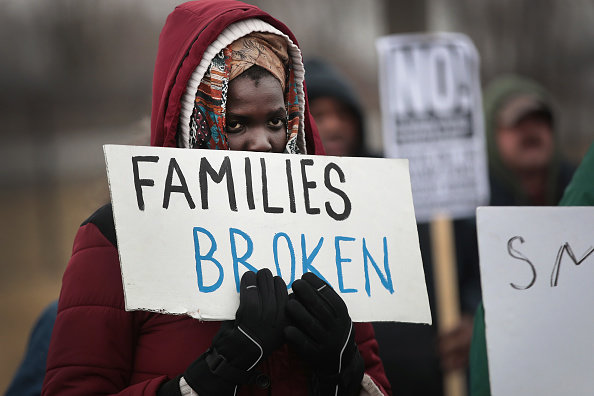Create a free profile to get unlimited access to exclusive videos, breaking news, sweepstakes, and more!
Why The Private Prison Industry Is Winning This Presidency

(A woman protests migrant deportations at the Gary-Chicago airport in Gary, Indiana. Photo: Getty Images)
“I didn’t come here because I wanted to,” says Laura Monterrosa, an El Salvadoran detainee at the Texas immigration detention center, who reportedly remains suicidal after a female guard allegedly assaulted her for four months. Monterrosa came to the US after sustaining abuse in El Salvador for being gay. She was put in solitary confinement in February because the facility does not have separate rooms for “segregation purposes.” Monterrosa is detained at the for-profit T. Don Hutto Detention Facility, a drive from Austin, Texas. Monterrosa, who has allegedly attempted suicide at least three times, was also reportedly denied therapy. She is not the first person to speak up about the conditions at T. Don Hutto. In 2015, a former guard was accused of assaulting eight women dating back to 2007.
One February 27, the Supreme Court ruled that people held in immigration detention are not entitled to a bond hearing—that is to say, they could be held indefinitely.
This ruling is happy news to the private prison industry.
This private immigration boom spells big money for an industry that had withered under the Obama administration, which had moved to phase out the privatization of federal prisons. ICE is opening five new private detention centers in Detroit, Chicago, St Paul, Salt Lake City, and southern Texas, alarming critics of the industry. In late 2017, ICE requested more than 51,000 detainee beds—a 25% increase from 2016. Private corrections corporations like GEO Group and CoreCivic each gave $250k to Trump’s inauguration.
60% of detainees are held in privately-run facilities. And the number of detainees keeps rising as ICE non-criminal arrests continue to rise.
Immigration detention centers are under scrutiny by human rights groups and the legal system for reports of medical neglect and deaths in custody. The conditions “undermine the protection of detainees’ rights, their humane treatment, and the provision of a safe and healthy environment,” said a watchdog report that found moldy food and mistreatment in unannounced visits to five facilities.
ICE is important to these companies. It made up 24% of GEO’s third-quarter revenue; Core’s ICE-related payments increased 142% between 2014 and 2016. GEO was recently awarded a ten-year contract with ICE to develop and operate a $110 million immigrant jail in Conroe, Texas, projected to generate a revenue of $44 million. All that money comes from taxes.
Why is ICE building detention centers in these areas? “They are well aware that the vast majority of detained immigrants do not have lawyers, and building new jails will deal a further blow to access to justice in immigration prisons,” says Heidi Altman, director of policy for the National Immigrant Justice Center.
The private prison industry is certainly “winning” this presidency—meanwhile, the ACLU says the industry is creating “serious gaps in accountability and transparency,” while the authors of a 2016 Hamilton Project paper haven’t found evidence that private prisons are cheaper for the government—or any more effective. What do you think?














